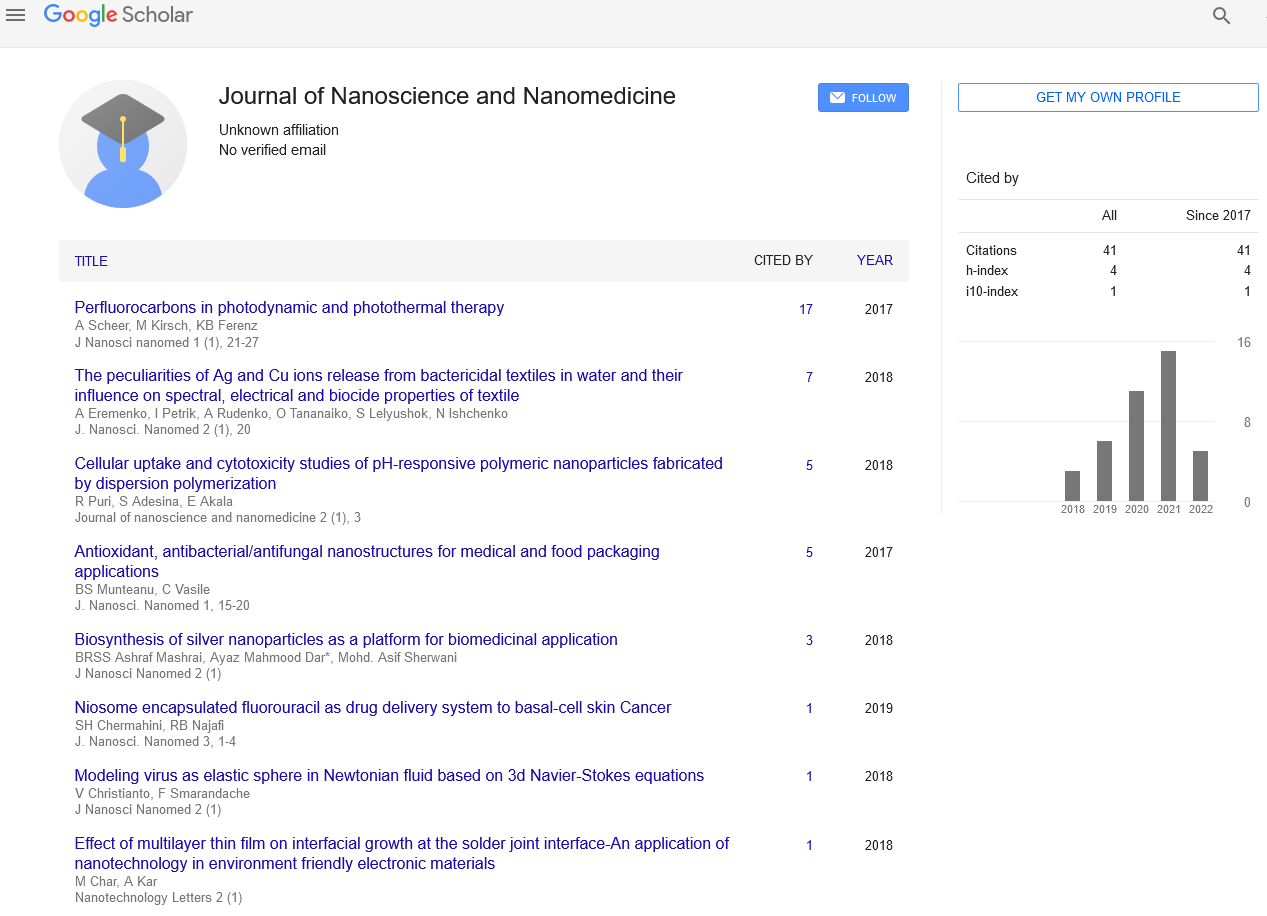Nitric oxide delivery in nontoxic nanoparticle-based cancer cells
Received: 04-Nov-2021 Accepted Date: Nov 15, 2021; Published: 23-Nov-2021, DOI: 10.37532/puljnn.21.5(6).05
Citation: Wang P. Nitric oxide delivery in nontoxic nanoparticle-based cancer cells. J Nanosci Nanomed 2021;5(6):5-6.
This open-access article is distributed under the terms of the Creative Commons Attribution Non-Commercial License (CC BY-NC) (http://creativecommons.org/licenses/by-nc/4.0/), which permits reuse, distribution and reproduction of the article, provided that the original work is properly cited and the reuse is restricted to noncommercial purposes. For commercial reuse, contact reprints@pulsus.com
Abstract
Nitric oxide (NO) appears incredible part in tumor science. Later a long time, increasingly inquires about utilized NO benefactor in tumor focusing on sedate conveyance and treatment. In this audit, we summarized the NO givers by their endogenous and exogenous jolts. At that point the application of NO givers, which was the most point of the audit, was talked about in point by point agreeing to their capacities, counting actuating tumor cell apoptosis, switching tumor multidrug resistance, repressing tumor metastasis and making strides medicate conveyance.
Keywords
Nitric oxide, Tumor, Exogenous jolts, Apoptosis
Introduction
A modern nanoparticle may move forward the viability of chemotherapy for children with neuroblastoma. The non-toxic nanoparticle conveys nitric oxide to particular cancer cells. Researchers found neuroblastoma cells treated with the nanoparticle required as it were one-fifth the dosage of chemotherapy, meaning less hindering side impacts to encompassing sound cells. The following step is to test the nanoparticle on other cell lines, such as lung and colon cancer cells, and to continue to in vivo tests. Cancer could be a most genuine risk for human being. The number of cancer patients in China accounts as tall as 21.07% of the national populace in 2014. Chemotherapy, radiotherapy, surgery and combinational treatment are the foremost common methodologies to oversee the cancer. Tragically, the cancer treatment result is distant from palatable. The mortality rate is still as tall as 167.89/100 000 at 2014, and it is steady in past a few a long time. The improvement of nanotechnology given novel definitions that can somewhat resolve the issues confronted in clinical application of chemotherapy, counting decreasing the necessity of harmful surfactants, dragging out blood circulation time and making strides tumor focusing on capacity. Be that as it may, most of these nanoparticles are restricted by their destitute clinical interpretation potential, whereas the clinical accessible nanomedicines are profited from their moo harmfulness and tall resilience measurements instead of great tumor focusing on capacity. In this manner, numerous analysts have committed their exertion to creating modern methodologies to make strides the antitumor impact [1].
Vaporous transmitters appear wide exercises in science. Until presently, three vaporous transmitters are broadly assessed, i.e. nitric oxide (NO), carbon monoxide (CO), and hydrogen sulfide (H2S). Among which, NO could be a most alluring vaporous transmitter that have been assessed over two decades, and a profoundly complex part of NO was found in tumor science. At tall measurements (μM–mM), it can straightforwardly actuate cell apoptosis through a few pathways, counting creating oxidative and nitrosative push, restraining DNA blend, hurting DNA and repressing DNA repair, smothering cellular breath, disabling cellular work and upgrading fiery responses. Besides, it can surrender different exercises, such as switching tumor multidrug resistance (MDR), restraining tumor metastasis, widening tumor vessels and progressing sedate conveyance. Due to the wide and tall action of NO, analysts have created numerous sorts of NO conveyance givers that can particularly discharge NO in target location beneath different jolts to diminish systemic toxicity [2].
To date, numerous considers are distributed utilizing NO giver to progress the tumor determination and treatment. As an dynamic vaporous transmitter, NO progressed tumor treatment by actuating tumor cell apoptosis, turning around MDR, repressing tumor metastasis and lifting medicate conveyance. Due to the multi-function of NO benefactor, there’s a drift to combine NO benefactors with different nanomedicines. Although it is sweet news, the potential side impact, particularly untimely discharge of NO ought to be paid with specific consideration. Moreover, the impact of NO is concentration-dependent, and moo concentration of NO seem advance tumor development whereas high concentration may restrain. In this manner, it is vital to assess the concentration of NO conveyed into tumors. Shockingly, in spite of the fact that most ponders claimed that they might conveyance tall level of NO (μM indeed mM) to the tumor, they as it were recognized the intracellular NO concentration by in vitro tests, no in vivo assessment was detailed. Moreover, the on-demand discharge capacity of current accessible NO benefactors was not particular sufficient. Givers with more delicate to jolts ought to be created [3].
REFERENCES
- Chen W, Sun K, Zheng R, et al. Cancer incidence and mortality in China. Chin J Cancer Res. 2018;30(1):1-12.
- Yang S, Gao H. Nanoparticles for modulating tumor microenvironment to improve drug delivery and tumor therapy Pharmacol Res. 2017;126:97-108.
- Khoei AR, Ghahremani P. Temperature-dependent multi-scale modeling of surface effects on nano-materials. Mech Mat. 2012;46:94-112.





